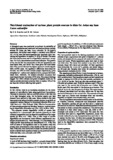Please note that the library staff will be unavailable to respond to queries or provide assistance from December 23 to January 2 due to the holiday break. Regular services will resume on January 3.
We appreciate your understanding and wish you a joyful holiday season!
We appreciate your understanding and wish you a joyful holiday season!
Growth and survival of juvenile tiger shrimp fed diet where fish meal is partially replaced with papaya (Carica papaya L.) or camote (Ipomea batatas Lam.) leaf meal
- Global styles
- MLA
- Vancouver
- Elsevier - Harvard
- APA
- Help

ดู/
วันที่
1995ผู้เขียน
Page views
4,892ASFA keyword
AGROVOC keyword
Taxonomic term
เมตาดาต้า
แสดงระเบียนรายการเต็ม
Share
นามธรรม
Fish meal is the major protein source in shrimp and fish diets but its continuous use would make it scarce and expensive. There are, however, potential substitutes like soybean or leaf meals. Papaya or camote leaf meals have not been tested as partial replacement for fish meal in diets for tiger shrimp. Thus, two feeding trials were made to test diets with leaf meals against a control shrimp diet. Both experiments used 50 mg shrimp stocked at 10 per 40 liters of sea water following standard water management. Trial 1 had diets containing either 17% soaked or unsoaked camote leaf meal or 16% papaya leaf meal. Results indicated that weight gain, specific growth rate and feed conversion ratio of the unsoaked papaya were similar to the control, higher than the unsoaked camote, but not significantly different (α= 0.05) from the soaked camote and papaya groups. Survival was not significantly different among treatments. Trial 2 used the best diet from Trial 1 - unsoaked papaya leaf meal - at 16%, 19% or 22% of the diet. The weight gain (1846%) of the shrimp fed 16% papaya leaf meal was not significantly different (α= 0.05) from the control 2034% but higher than the 22% group (1535%). Therefore, papaya leaf meal can partially replace (10%) animal protein in shrimp diets and serve as a source of exogenous proteolytic enzyme. However, its efficacy in culturing shrimp in ponds must be tested.
การอ้างอิง
Peñaflorida, V. D. (1995). Growth and survival of juvenile tiger shrimp fed diet where fish meal is partially replaced with papaya (Carica papaya L.) or camote (Ipomea batatas Lam.) leaf meal. The Israeli Journal of Aquaculture-Bamidgeh , 47(1), 25-33. http://hdl.handle.net/10862/1478
Type
ArticleISSN
0792-156Xคอลเลกชัน
- Journal Articles [1240]
Related items
Showing items related by title, author, creator and subject.
-
Evaluation of leguminous seed meals and leaf meals as plant protein sources in diets for juvenile Penaeus indicus
Eusebio, Perla S.; Coloso, Relicardo M. (Society of Israeli Aquaculture and Marine Biotechnology, 1998)The potential of locally available legumes (white cowpea, Vigna unguiculata, and green mung-bean, Vigna radiata) and leaf meals (papaya, Carica papaya, and cassava, Manihut esculenta) in combination with defatted soybean ... -
Nutritional evaluation of various plant protein sources in diets for Asian sea bass Lates calcarifer
Eusebio, Perla S.; Coloso, Relicardo M. (Wiley-Blackwell, 2000)A biological assay was conducted to evaluate the suitability of various leguminous seed meals and leaf meals as dietary protein sources for Asian sea bass, Lates calcarifer. In the growth experiment, fish (initial mean ... -
Terrestrial leaf meals or freshwater aquatic fern as potential feed ingredients for farmed abalone Haliotis asinina (Linnaeus 1758)
Reyes, Ofelia S.; Fermin, Armando C. (Blackwell Publishing, 2003)Three terrestrial leaf meals, Carica papaya, Leucaena leucocephala, Moringa oliefera and a freshwater aquatic fern, Azolla pinnata were evaluated as potential ingredients for farmed abalone diet. All diets were formulated ...





